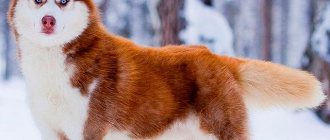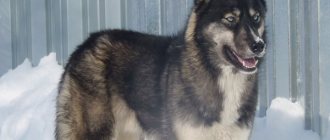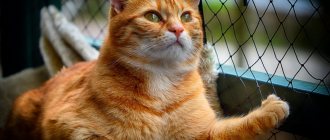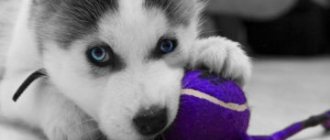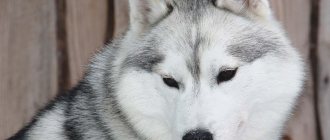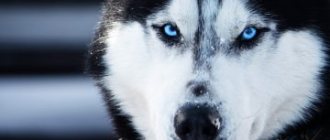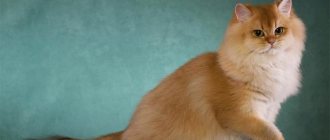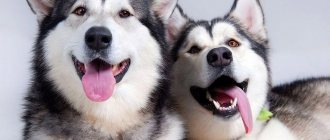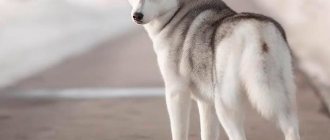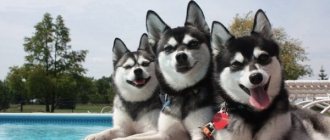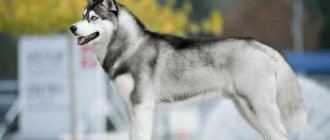Siberian Huskies have long ceased to be just sled dogs. They are distinguished by their calm and calm character, endurance, and kind attitude towards others, which is why dog breeders all over the world adopt charming puppies with blue eyes. Few people know which husky colors correspond to the standard, and which color is classified as a breed defect. Before you buy a cute little cat, it’s worth getting to know the most common color options for its coat.
What is the reason for the variety of colors?
Husky was bred by the peoples of the Far North based on local dogs and wolves. Selection for many centuries was carried out on the principle of selecting the most hardy and efficient individuals that can easily withstand harsh climatic conditions. They not only have to run in a harness, but also sleep in the snow. That is why minimal attention was paid to appearance, and the closest attention was paid to working qualities and health. This is how huskies of different colors appeared.
According to the standard approved by the IFF, the color can be anything from white to black. Different colors in all possible combinations, marks on the body or their complete absence are acceptable.
In the Russian Federation, the approach to this issue is more conservative - white color or its combination with black, gray or brown is considered the standard. But the rest of the colors are not considered a marriage, especially since Khasenys have such individual colors that it is extremely difficult to find two absolutely identical puppies.
Gray (wolf)
This color is very similar to the fur of a wild wolf .
This color is not rare.
Photo of a wolf-colored husky
The main coat color is ash-gray, the undercoat can be silver, cream or fawn.
Photo of a husky dog
By the way, the famous dog Balto from the cartoon had exactly this color, which is why he was considered a wolf.
Common Siberian Husky Colors
There is no clear classification of husky colors. Dogs differ in the location of spots, markings, facial mask, eye and nose color.
World dog experts distinguish not four (as in the Russian Federation) color variations, but about twenty. The most common among them:
- brown;
- gray;
- chocolate;
- fawn;
- silver
Brown
Another name for brown color according to the standard is red. Hasyats are often born with red tops and white bottoms. In summer, under the bright sun, the coat fades a little, turns pale and the tone becomes less saturated. During this period, huskies are more beige than brown, and they are called yellow, which is a mistake. The eyes, which have several color variations, give the animals a special charm and uniqueness. Brown dogs with blue eyes and dark “glasses” around them look especially impressive. Over time, they can disappear, turning into a slightly noticeable outline.
Very often, newly born Khasenys have a rich fiery color. After the first molt, the puppies change color and turn into a white dog with light brown spots.
Gray (wolf)
The gray color is called wolf because of its similarity to the color of predators. In addition to the main color, it contains small inclusions of red and fawn. The spots are most noticeable behind the ears, on the neck, thighs, legs and hocks. The undercoat of gray hasenies is beige, the rims of the eyes, lips and nose are black.
Very often, gray-white cats with blue eyes are born. The shade of the coat can be either light or dark, the undercoat can be gray, cream or beige. If the coat is silver, the undercoat is white, as is the belly and paws. The mask on the face and the upper back are gray. Hasyats with wolf coloring have brown, multi-colored or blue eyes.
Chocolate
The richness of the chocolate color of the coat varies - from light cream to dark brown. Copper-colored dogs, which are lighter and brighter than chocolate, look most impressive. In combination with blue eyes, the suit looks amazing. Eye rims, nose, lips should be brown. More often, white-chocolate hasyats are born - with a light bottom, a darker back, brown, blue or different eyes.
Pale yellow
The fawn color is close in tone to red, but not as rich, more subdued. A noble pastel shade reminiscent of cream or beige. The pigmentation of the rims of the eyes, lips and nose is brown.
If the chicks are born fawn-white, the top of the body is initially brighter. Over time, the shade fades and differs very little from the main color.
Silver
The most striking of the light husky colors is silver. In the sun, the coat shimmers due to the combination of the white background of the undercoat and the shiny gray guard.
In silver-white huskies, the mask is clearly expressed, as is the “arrow” on the forehead. Such Khasenys are characterized by dark eye rims and a bright blue iris. Another name for the silver color is “silver”.
Grooming and hygiene
Huskies have a smooth, thick coat and a soft, fluffy undercoat. Once a week, your pet needs to be brushed. First, go over the wool with a slicker brush. Movements should be careful and smooth so as not to damage the coat. Then you can go over the top with a long-toothed comb.
Molting occurs 2 times a year. During this period, the pet needs to be combed daily.
The coat of puppies is formed before 6 months of age. To avoid damaging the coat, the puppy should be brushed with a gentle, soft brush.
Until the age of three months, the puppy cannot be bathed. Baby's skin is sensitive to chemicals.
An adult dog is bathed 2-3 times a year. You shouldn't do this more often. The skin is covered with a protective layer, which is washed off with shampoo. Because of this, your pet may experience skin irritation.
A special shampoo is required for bathing. The pet needs to be wet and soaped. Be careful not to get soap into your eyes or ears. Rinse off the foam with warm, clean water. Afterwards, dry the dog with a towel and dry it with a hairdryer.
This is interesting! Huskies have practically no smell. This breed is perfect for those who cannot stand the dog smell.
- Don't forget about the eyes. Once a week they need to be wiped with a cloth moistened with clean water.
- Clean your ears once a week using cotton swabs.
- Brush your teeth once a month with a special brush and tooth powder.
Huskies are active and need long walks, so their nails must wear down on their own. But if this does not happen, the tips of the nails should be trimmed using a special nail clipper or ordinary nippers.
Thus, northern huskies delight dog breeders with a variety of colors. Some of them are more suitable for exhibitions, others are valued in sports.
The most striking feature of the breed is the mask, which can be found in almost all colors. It gives the muzzle a meaningful and unusual expression. And gray dogs are almost indistinguishable from wolves.
Rare husky colors
The most common color is gray. A white dog with blue eyes is not common, as are the rare husky colors presented in the table:
| Color | Description |
| White | Another name is snowy. Dogs have white not only guard hair, but also undercoat. Eyes are light brown, blue or different. |
| Soboliny (sable) | Sable Khasenysh with a bright copper undercoat. The spine is gradient - the color at the base is beige, and at the end it is dark gray, black-brown. The lips and eye rims are black. The nose may be brown. |
| Piebald | Piebald or spotted coloring involves a white background, occupying at least 70% of the husky's coat, and colored markings. They are of different shapes (round, asymmetrical) and colors (from red to black). Another name for the piebald color is pibold. |
| Black | There are no completely black huskies. Lighter markings are required on the legs, tail, and chest. If the pure charcoal color is at least 75%, the dog is classified as black or called an Afro Husky. |
| Black and white | In black and white, the percentage of the two colors is approximately the same. Dark back, main part of tail, outer side of ears. White muzzle with a mark on the forehead and paws. |
| Splash coat | Splash Coat Husky and Peebold are often confused. This is no coincidence. Both are black and white, with blue eyes, only the number and shape of the markings are different. Their arrangement in splash coats is often called “coat and cap”. The main difference is that there is more white than black and there is a light ring on the neck. |
| Tricolor | The background is black, and the muzzle, paws and chest are snow-white. A distinctive feature of the tricolor is the red markings near the eyes, on the body and limbs. The husky's undercoat can be yellow, peach or orange. |
| Marble | Rare huskies with a black muzzle, back, tail and hips, a random arrangement of spots on a light background. Markings of gray color of varying intensity. Eye rims, nose and lips are black. |
| Isabella | The dog has white fur with a fawn-colored awn. Eyes, nose, mucous membranes are brown. |
| Agouti | A rare color in which the hairs come in three shades at once - white, black and red. In combination with blue eyes, the husky looks menacing and unusual. |
| Cheprachny | A special feature of the saddle coat color is a dark saddle-shaped spot on the back. The mark, located on a snow-white background, can be of all types of colors - red, chocolate, gray and others. |
Absolutely black
Another name for the color is Afrohusky .
Due to genetics, huskies cannot have a blue-black
Black Husky
For a dog to be classified as this color, 75% of its coat must be black.
Photo of a black husky
Moreover, interspersed hairs of a different shade are allowed on the face, tip of the tail and paws.
Husky color features
The individuality of each Khasenysh is determined by the special expression of the muzzle, depending on the shade of the iris, nose and lips. What makes a dog unique is the shape and color of the mask on its face. Some puppies immediately look menacing, while others are cute and good-natured even as adults.
Nose
The shade of the nose depends on the color of the dog:
- Black - for pure black, gray, silver and brown.
- Brown – in chocolate, piebald and isabella.
- Pink or flesh-colored - white ones have it.
- Snowy - dark with brown spots, found in variegated colors.
If the nose is partially depigmented, it is considered a fault.
Eyes
The eyes of Siberian sled dogs are very expressive due to the bright colors of the iris, which can be:
- Blue - the shade remains unchanged throughout life.
- Brown is so rich that it is often mistaken for black.
- Amber is a light shade of brown, found in red, snow and chocolate specimens.
- Heterochromia – different eyes (blue combined with amber or brown).
- Interspersed with brown spots on the blue iris.
- Split – the iris is divided into two halves of different colors.
Black and tan huskies with blue eyes, white and brown and many others look very impressive. The more unusual the eye color, the higher the price of a puppy.
"Mask"
For hasyats of any color, a characteristic feature is the presence of a “mask” on the face. It has clear boundaries, light or dark, and forms patterns of different shapes and types:
- shamrock;
- wolf;
- with a stripe on the bridge of the nose;
- heart;
- glasses;
- open;
- with eyebrows.
Ginger
The most striking example of the color of this breed.
Photo of a red Siberian Husky puppy
The fiery fur shimmering in the sun makes its owner look like a fox .
Photo of a red husky
There is no need to confuse red fur with chocolate - these are two different colors .
Do Huskies love children?
Piebald (peebold, pinto)
The main difference between dogs with this color is pronounced spotting.
Photo of Peebold Husky
The fur itself is white , with rounded multi-colored spots scattered throughout it.
Husky pinto puppy
The nose, lips and fur around the eyes are brown, if the spots are closer to red , or black.
A little history
The Husky breed originates in the snowy lands of Siberia. In the 1930s, the Chukchi and Eskimos inhabiting the northern regions were able to domesticate this interesting breed, which contains a mixture of a wolf and a northern dog. They needed an animal that could transport people and cargo over very long distances. The harsh climate served to shape the character and endurance of the animal.
Today, huskies are divided into three categories - sledding, sporting and exhibition. According to the standard, this is a sled breed. Americans loved them very much, making them a popular treasure of the country. But so that no one forgets their roots and where they come from, the dogs were named Siberian Huskies.
Summarizing
Husky is a wonderful breed for dynamic and athletic people who prefer to spend their free time actively. It is with such owners that all the natural beauty and potential of this dog will be revealed. The white husky is a color variety of the breed that does not differ from its other representatives in anything other than its spectacular color.
Therefore, a person who wants to own a snow-white husky will be faced with the same nuances and characteristics of the breed as the owners of huskies of any other color. Perhaps a white husky proudly walking on a leash or flying through the snowdrifts and pulling a sled behind it will attract many times more admiring glances.
Breed standards
Huskies are similar in genotype to wolves. The dogs are very muscular, with a developed skeleton, large, especially males. At the withers, height reaches 60 cm, weight - from 16 to 27 kg. Standard breed description:
- Head. From the back of the head to the eyes, the skull narrows, the size is medium, the shape is proportional to the body. The muzzle is the same length as the skull and ends with a nose, the color of which depends on the color of the coat. According to the standard, the lobe may have pink veins. In this case, the nose is called snowy.
- Eyes. Almond-shaped, brown or blue.
- Ears. Small, triangular, close-set.
- Rib cage. Not very wide, but strong.
- Tail. In a calm state, the tail hangs down, and in an excited state it is sickle-shaped. It should not fall to the side or lie against your back.
- Wool. The hair is soft, there is a dense, fluffy undercoat, which falls out during shedding.
These are standard criteria for selecting a quality dog. Most of the characteristics are noticeable from puppyhood, so choosing a purebred will not be difficult.
Most characteristics are noticeable already in puppyhood
Are there other varieties?
There is only one variety of this breed - the Siberian Husky. These are the dogs that can be seen on the street, at exhibitions, in films and in photographs popular on the Internet.
They are also used as sports and riding vehicles. Currently, there are few working huskies left, since dogs of show lines, which are in greatest demand among buyers, are mainly bred.
Siberian Huskies have also gained popularity as pets and companions. This was facilitated by their friendly disposition, lack of aggression towards humans and love for children. Also, a significant role in the popularization of the breed was played by the fact that huskies are one of the few breeds whose representatives have blue eyes and even heterochromia.
Touched by the appearance of these dogs, people sometimes lose sight of the fact that huskies are not suitable for guarding and that they make poor hunting assistants.
Now let's talk about dogs that, while not being subspecies of this breed, nevertheless have similarities and often common origins with the Siberian Husky.
Sable
The coat color is unusually beautiful and is rare.
The main shade is brown, red, copper-chocolate.
Sable Husky
The undercoat is usually light brown in color, the upper edge of the hairs is gray or black.
Husky dog sable color
The fur on the face may look like a black “mask”.
External characteristics of an adult
Siberian Huskies are light, active, compact dogs. They have a strong build, long and fast limbs. Representatives of the breed exhibit sexual dimorphism, females are much smaller than males.
Adults, according to the requirements of the standard, must meet the following parameters:
Maximum height and weight
The weight of Siberian Huskies should be proportional to their height. Exceeding the parameters is considered grounds for disqualification. The height of a male dog at the withers varies from 54 to 60 cm. Females are shorter, their height is from 51 to 56 cm. The approximate weight of males is from 21 to 28 kg, females from 16 to 23 kg, respectively.
Wool and color features
Huskies are dogs with medium-length hair. In appearance, the coat is very beautiful, creating the effect of light pubescence. The outer hair is smooth and straight. There is a soft and thick undercoat. Shaggy and harsh coat is considered a fault.
The coat colors of Siberian Husky dogs range from pure white to black. Officially, the standard allows for many variations. The most common are:
- completely white;
- white with gray;
- White black;
- solid black;
- ginger;
- pale yellow;
- copper.
Ears, tail
The ears of dogs of this breed are medium in size, triangular in shape, with slightly rounded tips. Located high, at a distance from each other. If the tips point to the sides rather than up, this is considered a fault.
The tail, if the dog is in a calm state, is below the line of the back, lowered down. If a husky is interested or excited about something, its tail bends upward like a sickle.
How to choose a puppy?
You should only purchase a black husky puppy through a kennel club or a reputable kennel. At the same time, before purchasing, you should try to find out what kind of reputation a particular breeder enjoys among dog owners.
When you arrive to pick up a puppy, you must first of all talk to the owner of the kennel and look at the baby’s parents. If the mating was outside, then you won’t be able to see the father of the puppies, but if for some reason the breeder does not want to show their mother, then this should raise red flags.
NOTE!
Puppies should look well-groomed, fairly well-fed and healthy. They willingly play with each other and show a friendly interest in people. If kids behave aggressively or cowardly, you should refuse the purchase.
When choosing a black husky, you need to remember that the puppy must have white, grayish or fawn markings.
Character traits
Red huskies are distinguished by their lively, but at the same time, friendly and calm disposition. They are smart, quick-witted, and with the right approach to training, they remember new commands well.
These dogs are good with children and willingly play with them, however, you should not trust a child to raise and train a husky, as representatives of this breed tend to be stubborn and can even become disobedient.
Red huskies are able to adapt to different living conditions and are suitable for both outdoor and indoor living.
NOTE!
These dogs are not naturally vicious towards strangers, which is why they are not suitable for the role of guards for a house or apartment.
Huskies also make bad hunters: they have a hunting instinct, which is why these dogs can catch small animals, for example, rodents or poorly flying birds, but they will not give the prey to the owner, but will try to eat it before he has time to stop them .
